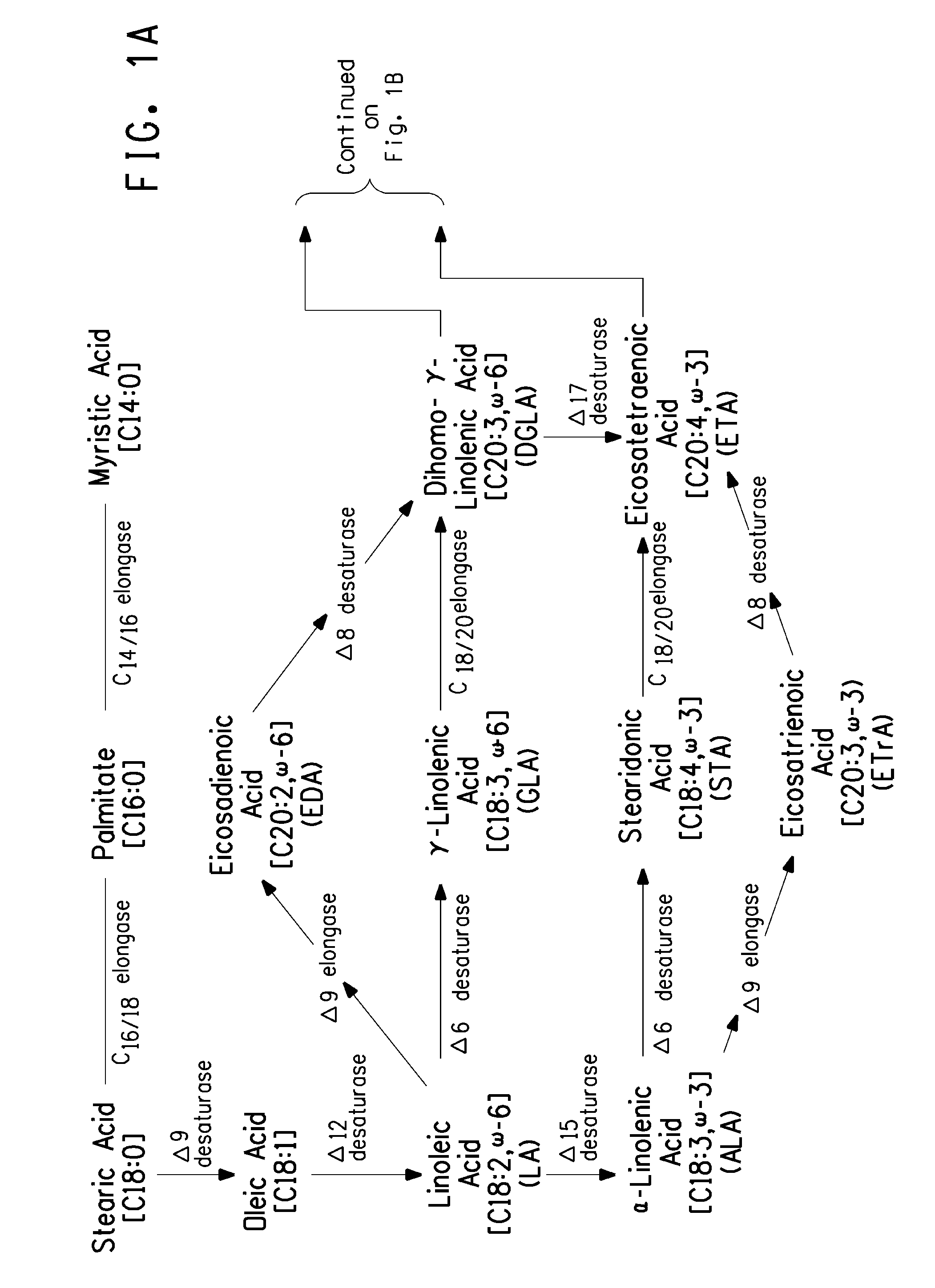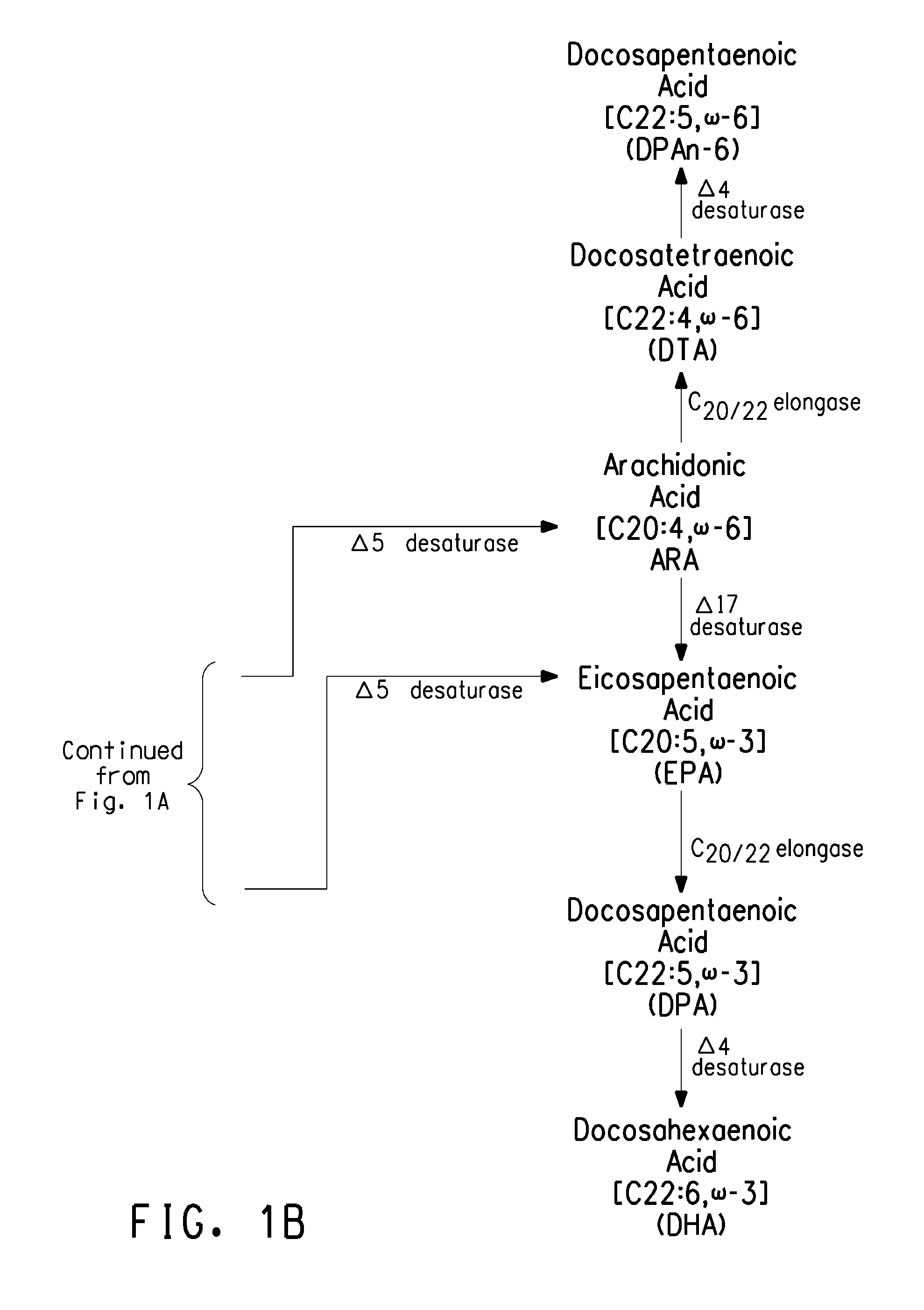Optimized strains of yarrowia lipolytica for high eicosapentaenoic acid production
a technology of yarrowia lipolytica and eicosapentaenoic acid, which is applied in the field of biotechnology, can solve the problems of increased levels and decreased production of undesired pufas
- Summary
- Abstract
- Description
- Claims
- Application Information
AI Technical Summary
Benefits of technology
Problems solved by technology
Method used
Image
Examples
example 1
[0410]Generation of Yarrowia lipolytica Strain Y4086 to Produce about 14% EPA of Total Lipids Via the Δ9 Elongase / Δ8 Desaturase Pathway
[0411]The present Example describes the construction of strain Y4086, derived from Yarrowia lipolytica ATCC #20362, capable of producing about 14% EPA relative to the total lipids via expression of a Δ9 elongase / Δ8 desaturase pathway (FIG. 3).
[0412]The development of strain Y4086 required the construction of strain Y2224 (a FOA resistant mutant from an autonomous mutation of the Ura3 gene of wildtype Yarrowia strain ATCC #20362), strain Y4001 (producing 17% EDA with a Leu− phenotype), strain Y4001U (Leu− and Ura− phenotype), strain Y4036 (producing 18% DGLA with a Leu− phenotype), strain Y4036U (Leu− and Ura− phenotype) and strain Y4070 (producing 12% ARA with a Ura− phenotype). Further details regarding the construction of strains Y2224, Y4001, Y4001U, Y4036, Y4036U and Y4070 are described in Example 7 of PCT Publication No. WO 2008 / 073367, hereby i...
example 2
Generation of Yarrowia Lipolytica Strain Y4128 to Produce about 37% EPA of Total Lipids Via the Δ9 Elongase / Δ8 Desaturase Pathway
[0418]The present Example describes the construction of strain Y4128, derived from Yarrowia lipolytica ATCC #20362, capable of producing about 37.6% EPA relative to the total lipids (i.e., greater than a 2-fold increase in EPA concentration as percent of total fatty acids with respect to Y4086).
[0419]The development of strain Y4128 required the construction of strains Y2224, Y4001, Y4001U, Y4036, Y4036U, Y4070 and Y4086 (described in Example 1), as well as construction of strain Y4086U1 (Ura−).
Generation of Strain Y4086U1 (Ura−)
[0420]Strain Y4086U1 was created via temporary expression of the Cre recombinase enzyme in construct pY117 (FIG. 5B; SEQ ID NO:128; described in PCT Publication No. WO 2008 / 073367) within strain Y4086 to produce a Ura− phenotype. This released the LoxP sandwiched Ura3 gene from the genome. The mutated Yarrowia acetohydroxyacid synth...
example 3
[0427]Generation of Optimized Yarrowia lipolytica Strain Y4305 to Produce Greater than 53% EPA of Total Lipids Via the Δ9 Elongase / Δ8 Desaturase Pathway
[0428]The present Example describes the construction of strain Y4305, derived from Yarrowia lipolytica ATCC #20362, capable of producing greater than 53% EPA relative to the total lipids via expression of a Δ9 elongase / Δ8 desaturase pathway (FIG. 3).
[0429]The development of strain Y4305 required the construction of strains Y2224, Y4001, Y4001U, Y4036, Y4036U, Y4070 and Y4086 (described in Example 1), strains Y4086U1 and Y4128 (described in Example 2), as well as strain Y4128U3 (Ura−), Y4217 (producing 42% EPA of total lipids), Y4217U2 (Ura−), Y4259 (producing 46.5% EPA of total lipids) and Y4259U2 (Ura−).
Generation of Y4128U Strains
[0430]In order to disrupt the Ura3 gene in strain Y4128, construct pZKUE3S (FIG. 6B; SEQ ID NO:130) was created to integrate a EXP1::ME3S::Pex20 chimeric gene into the Ura3 gene of strain Y4128. Plasmid pZ...
PUM
| Property | Measurement | Unit |
|---|---|---|
| weight percent | aaaaa | aaaaa |
| weight percent | aaaaa | aaaaa |
| weight percent | aaaaa | aaaaa |
Abstract
Description
Claims
Application Information
 Login to View More
Login to View More - R&D
- Intellectual Property
- Life Sciences
- Materials
- Tech Scout
- Unparalleled Data Quality
- Higher Quality Content
- 60% Fewer Hallucinations
Browse by: Latest US Patents, China's latest patents, Technical Efficacy Thesaurus, Application Domain, Technology Topic, Popular Technical Reports.
© 2025 PatSnap. All rights reserved.Legal|Privacy policy|Modern Slavery Act Transparency Statement|Sitemap|About US| Contact US: help@patsnap.com



